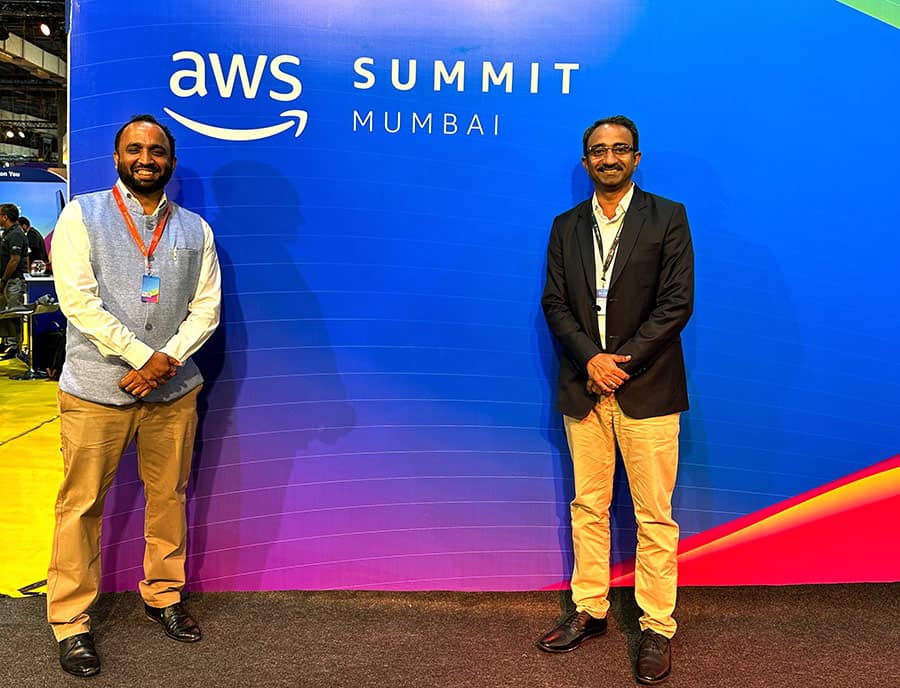Prabhu Ram, Head – Industry Intelligence Group
During the recent AWS Summit in Mumbai, I had the opportunity to engage in a conversation with VG Sundar, Director of Business Development, AWS India Pvt. Ltd.
Organizations who derive the greatest benefits from the cloud are those with a well-defined strategy focused on gaining a competitive advantage.
On Enterprise Modernization
While cost considerations are always present, these customers also prioritize enhancing end customer experiences, improving employee experiences, and increasing agility in launching new products or lowering price points. To achieve these goals, they adopt a backward-thinking approach, envisioning the desired changes and determining how best to leverage the cloud. This process requires careful modernization planning and the establishment of effective governance, including financial operations and architectural governance. Even for simple lift and shift migrations, strong governance is crucial when integrating with partners, capturing data from external devices, and connecting with SaaS providers.
Modernization is gaining prominence, with a growing enterprise realization that governance and modernization go hand-in-hand. Contrary to common belief, governance does not impede progress; rather, it acts as a catalyst for success. Many individuals perceive governance as a potential obstacle, fearing it will slow them down. However, the truth is that governance helps enterprises rewire and reduce future risks, ultimately propelling them forward. By establishing guardrails early on, enterprises can actually drive faster towards their goals. Although it may initially seem counterintuitive, effective governance serves as an accelerator in the cloud modernization journey.
When it comes to modernization, the AWS strategy encompasses addressing different customer scenarios, by focusing on lift and shift, guiding customers interested in modernization options, and collaborating with ISV vendors to modernize their applications.
On Generative AI
Amazon has been leveraging AI and ML capabilities across business units for a long time now. Amazon Bedrock, for instance, provides the easiest way to build and scale generative AI applications with an array of foundation models (FMs) from leading AI start-up model providers, including AI21, Anthropic, and Stability AI, alongwith providing exclusive access to the Titan family of foundation models developed by AWS.
Generative AI offers three main use cases. Firstly, it enables personalized experiences on e-commerce platforms by generating customized text based on images. This enhances the browsing experience for users with tailored product descriptions. Secondly, it automates transactional processes through the use of bots, increasing efficiency by reducing the need for human intervention unless necessary. Lastly, it synthesizes data from various sources, such as contracts, invoices, and external information, to create comprehensive summaries. This streamlines tasks like vendor negotiations, saving time and improving decision-making. Similar benefits can be seen in healthcare and insurance industries, where AI simplifies data analysis and improves overall quality of care or operational processes. Overall, AI-powered automation improves efficiency, productivity, and insights across a range of applications.
On Drivers for Enterprise Cloud Adoption
As organizations increasingly migrate to the cloud, the reasons behind this shift have evolved beyond cost and innovation. Over the past few years, a new imperative has emerged: future-proofing businesses. This concept encompasses two significant changes that have prompted businesses to embrace cloud technology.
Firstly, the importance of business continuity in the face of unprecedented disasters has become evident. Many companies discovered that their disaster preparedness fell short when traditional approaches proved ineffective. Lockdowns and restricted access to data centers and disaster recovery sites highlighted the need for robust automation and remote accessibility. The absence of key personnel exposed vulnerabilities that could have been mitigated with better automation systems.
Secondly, the transition to fully digital or “phygital” transactions has become a necessity. As physical meetings became impractical, businesses had to quickly adapt their customer journeys, reconsider rules engines and forecasting tools, and even redefine key performance indicators. While early adopters have successfully navigated these changes and reaped the benefits, others are still grappling with application transformation, facing the more complex challenge.
On Enterprise Cloud Adoption in Automotive
In the mobility space, there are distinct use cases that AWS is observing. Firstly, there are electric vehicle management platforms being moved to the cloud, where pre-built applications serve as the foundation for battery management and predicting charge points. Secondly, connected vehicles, whether electric or not, are being retrofitted with devices for better tracking and various purposes like predicting maintenance needs or monitoring driver behaviour. Thirdly, in the commercial sector, companies are utilizing data to provide fleet owners with valuable applications for tracking driver behaviour and enhancing safety features.
Additionally, the emerging trend is to offer vehicles or specific services, such as tyres, on a rental or pay-per-use basis. Predictive maintenance, enabled by machine learning, allows for efficient replacement scheduling. Another significant area of focus is infotainment in passenger vehicles, offering a wide range of interactive games, videos, and content to keep passengers engaged.
For instance, Apollo Tyres is embracing digital transformation by leveraging the cloud to enhance its tyre manufacturing process and deliver greater value to customers. With a daily production exceeding 2,425 tons across global factories, Apollo Tyres aims to optimize its infrastructure for improved visibility and operational efficiency. By establishing a data lake on AWS, the company has consolidated its IT infrastructure onto the cloud platform, and leverages advanced technologies like IoT and data analytics. This enables precise management of machine utilization and high-quality tyre production. Apollo Tyres plans to connect all factories to the cloud, migrating mission-critical applications to AWS for enhanced customer experiences and streamlined processes.
Ashok Leyland is the second largest manufacturer of commercial vehicles in India and the 4th largest manufacturer of buses in the world. Ashok Leyland successfully migrated its telematics platform to AWS, accommodating a fleet of 120,000 vehicles and continuously expanding with the addition of 7,000 vehicles each month.
On Enterprise Cloud Adoption in BFSI
The BFSI sector has experienced significant acceleration in cloud adoption. Initially, NBFCs and insurers were the frontrunners due to their unique user experiences, diverse data capture, and risk profiles. The high volume of transactions made cloud adoption a natural choice for them. However, the COVID-19 pandemic altered the landscape. Existing cloud users realized the value of cloud resilience when physical accessibility was restricted. This prompted more companies to recognize the benefits of cloud adoption for future-proofing their operations. Risk profiles also underwent a transformation, requiring adjustments to rules engines and data collection. Customer preferences shifted towards digital interfaces, leading to the rise of “phygital” experiences. Additionally, flexible insurance products increased transaction volumes. Overall, the BFSI sector is witnessing a dynamic shift towards cloud technology, creating new opportunities for innovation and growth.
For example, Axis Bank is drawing on the breadth and depth of AWS services, including containers, database, and compute, to build a portfolio of new digital financial services. Axis Bank is in the process of migrating 70% of its data center infrastructure to the Cloud, aiming to cut costs, increase agility, and enhance customer experience. With 200Mn digital-savvy customers, the bank offers innovative digital banking services like online accounts in under six minutes and instant digital payments. This transition has led to a 35% rise in customer satisfaction and a 24% cost reduction. Axis Bank has deployed over 25 mission-critical applications on AWS, including Buy Now Pay Later (BNPL), loan management, Account Aggregator, V-KYC, and WhatsApp Banking.
In conclusion, cloud adoption is accelerating and it has profound impact on organizations across various sectors. With a growing and strong focus on modernization, governance, and the transformative potential of generative AI, enterprises are well-positioned to thrive in the digital age.













